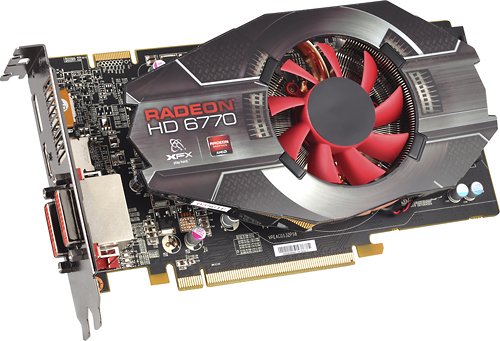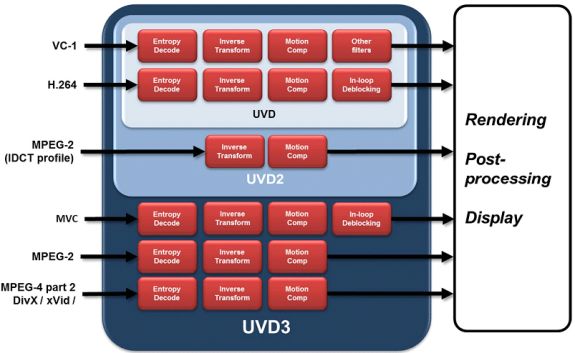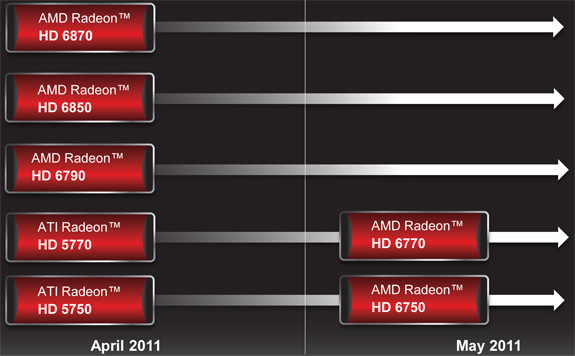AMD’s Radeon HD 6770 & Radeon HD 6750: The Retail Radeon 5700 Rebadge
by Ryan Smith on April 28, 2011 12:01 AM ESTWe haven’t talked about it beyond a passing comment, but AMD still has some Radeon 6000 series cards that are OEM-only. We are of course referring to the Radeon HD 6770 and Radeon HD 6750, AMD’s Juniper-powered 5770 & 5750 rebadges for OEMs. While we’ve only recently seen the rest of the Northern Islands lineup launch in the retail space, in the OEM space the last-generation Juniper GPU has been filling out AMD’s lineup between Turks (6500/6600) and Barts (6800) based video cards.
The rationale for OEM space is rather straightforward: OEMs want/need something new to sell. More RAM, a Sandy Bridge CPU, a SSD – their 2011 computers need to look better than their 2010 computers, as they certainly don’t want to be seen as selling last year’s model for anything less than a steep discount. It was perhaps a foolish hope that these shenanigans would remain in the OEM market, as so far AMD has continued to keep the 5770 and 5750 even after the rest of Northern Islands has launched. But here we are, out with the old and in with the old: the 5770 and 5750 are getting rebadged in retail. Say hello to the Radeon HD 6770 and Radeon HD 6750.
| AMD Radeon HD 6770 | AMD Radeon HD 5770 | AMD Radeon HD 6750 | AMD Radeon HD 5750 | |
| Stream Processors | 800 | 800 | 720 | 720 |
| Texture Units | 40 | 40 | 36 | 36 |
| ROPs | 16 | 16 | 16 | 16 |
| Core Clock | 850MHz | 850MHz | 700MHz | 700MHz |
| Memory Clock | 1.2GHz (4.8GHz data rate) GDDR5 | 1.2GHz (4.8GHz data rate) GDDR5 | 1.15GHz (4.6GHz data rate) GDDR5 | 1.15GHz (4.6GHz data rate) GDDR5 |
| Memory Bus Width | 128-bit | 128-bit | 128-bit | 128-bit |
| VRAM | 1GB | 1GB | 1GB | 1GB |
| FP64 | N/A | N/A | N/A | N/A |
| Transistor Count | 1.04B | 1.04B | 1.04B | 1.04B |
| Manufacturing Process | TSMC 40nm | TSMC 40nm | TSMC 40nm | TSMC 40nm |
| Price Point | ? | ~$110 | ? | ~$110 |
There’s really no way to sugarcoat it, and even AMD isn’t really trying. It’s the same Juniper GPU on the same boards with the same clocks, the same power requirements, and the same performance. The only thing different between a 5700 series card and its 6700 series counterpart is the sticker on the card, the BIOS, and quite possibly the price.

Image Courtesy Best Buy

Image Courtesy Newegg
However to be fair to AMD, they have at least made some effort to improve on the 6700 series over the 5700 series through the BIOS. As you may recall, one of the big differences for the 6000 series over the 5000 series is that the 6000 series got HDMI 1.4a support, along with a UVD3 video decoder that was capable of decoding the additional resolutions and bitrates Blu-Ray 3D’s MVC(H.264) profiles require. These changes have been backported to Juniper to some extent.
UVD2.2 is fast enough to process MVC, so now the 6700 series can decode Blu-Ray 3D. Without any hardware on hand we can’t specifically test this, but we suspect AMD may have introduced a new PowerPlay state (or edited an existing one) to further ramp up Juniper’s core clocks when playing MVC content, as this would be the most practical way to increase the max bitrate UVD2.2 can handle, if indeed it couldn’t handle MVC bitrates at the usual core clocks. Update: AMD has confirmed our theory. In fact the UVD3 also have a Blu-Ray 3D PowerPlay state, which means UVD2 and UVD3 may be more similiar than we once thought.
Meanwhile HDMI 1.3 and HDMI 1.4a both have the same bandwidth requirements, so now the 6700 series is HDMI 1.4a capable through some BIOS magic – although we haven’t been able to get confirmation that this support extends beyond support for the frame-packed formats required for HDMI 3D, or in other words it may not support 2K x 4K resolutions and other features normally associated with HDMI 1.4a. Update: AMD confirmed that the 6700 series only supports the HDMI 3D portions of the HDMI 1.4a spec. Apparently this is consistent with Northern Islands, whcih doesn't support 2K x 4K resolutions over HDMI either.

The good news here is that we’re not immediately aware of any reason why these features can’t be fully backported to existing 5700 series cards. Although AMD technically refers to UVD2.2 having “firmware”, as far as we know everything is contained in the video card’s BIOS. If this is the case, then for any 5700 series designs being recycled for the 6700 series, it should be easy to use the 6700 series BIOS. Of course this wouldn’t be something AMD supports.
Ultimately AMD considers this rebadging a necessity to some degree. While everyone is free to speculate on whether there are ulterior motives, what is clear is that the 5700 series created a branding problem for AMD: the 5000 series was launched before ATI was rebranded AMD. So the 5770 and 5750 are still technically “ATI” cards, this being nearly 8 months after ATI was fully rebranded to be part of AMD. At the same time this makes AMD’s product stack consistent from top to bottom for both retail and OEMs: every current card from the 6450 to the 6990 is now a 6000 series cards. It’s not a particularly good reason, but it is what it is.

Ultimately our biggest concern at this point is pricing. AMD tells us that 6700 series pricing will be consistent with 5700 series pricing, but we have our doubts. 5770 has actually been really good – it regularly goes on sale for as low as $95, so if you don’t mind a MIR and the choice of only a couple of vendors, you’ve been able to grab a 5770 for under $100. This is cheaper than the 5750 most of the time, never mind what it does to the 6670 and NVIDIA’s lineup. What is NVIDIA’s lineup? The slightly faster GTX 550 Ti at $125+, and the 5750-like GTS 450 at $90+. Compared to everything AMD and NVIDIA, the 5770 is a very good deal; and this is why we’re concerned about the pricing.
| Radeon HD 5700 Series Price History | |||||
| Launch | Today | Difference | |||
| Radeon HD 5770 | $160 | Approx $110 | -$50 | ||
| Radeon HD 5750 | $130 | Approx $110 | -$20 | ||
We hope to be proven wrong here, but at this point in time there’s little reason for AMD and their partners to sell $100 5770s when there’s no competitive pressure to do so. A good bargain is another name for a product bringing in less profit than it should, and in the cut-throat semiconductor industry you usually need to grab what you can when you can. The concern we have is that it’s as good a time as any to realign 5770 prices with the competitive market and AMD’s product stack – it’s time for a price hike. There is no doubt in my mind that the first 6700 cards will cost more than the cheapest 5700 cards. The only question is whether prices will come back down once stores are fully stocked with 6700 cards as they are today with 5700 cards.
At the end of the day this rebadging seems to only benefit AMD and their partners, to the detriment of buyers. In a weird twist it’s a bit better than how they handled the 6800 series – at least the 6700 series isn’t slower than the 5700 series – but that’s not saying much. Besides the backported MVC/HDMI 1.4a features, the 6700 series lacks everything else that made the rest of the 6000 series an improvement over the 5000 series. There’s no DisplayPort 1.2, no MPEG-2 or MPEG-4 ASP decoding, no color correction, no improved tessellator, and no linear space color correction. With the exception of perhaps DP1.2 they’re not headlining features, but they’re glaring inconsistencies.
When NVIDIA played the rebadge game with G92 it didn’t help consumers then, and with AMD doing it today, it doesn’t help consumers now. Actually, G92 ultimately got a die shrink from 65nm to 55nm and various clockspeed bumps, so unless AMD makes a 28nm Juniper core this may end up being a worse deal.
It’s perhaps with a twinge of sadness to see this happening to Juniper. Juniper above all other AMD GPUs has been AMD’s workhorse. It was the GPUs game developers first saw in the summer of 2009 when AMD sampled their first DX11 parts, and we’re now coming up on 2 years later where it’s still selling strong. We’re glad to see it live on – it’s a great card and continues to be so at $99, but the rebadging adds a permanent tarnish to the reputation; an air of taking advantage of uninformed buyers that it will never escape. This would seem to be the fate of any GPU fortunate to live long enough to cross multiple generations: if you aren’t replaced, you’re renamed.
| April 2011 Video Card MSRPs | ||
| NVIDIA | Price | AMD |
| $700 | Radeon HD 6990 | |
| $480 | ||
| $320 | Radeon HD 6970 | |
| $260 | Radeon HD 6950 2GB | |
| $240 | Radeon HD 6950 1GB | |
| $200 | Radeon HD 6870 | |
| $160 | Radeon HD 6850 | |
| $150 | Radeon HD 6790 | |
| $130 | ||
| ? | Radeon HD 6770 | |
| $99 | Radeon HD 6670 | |
| $95-$110 | ||
| $79 | Radeon HD 6570 | |
| $50-$70 | Radeon HD 5570 | |
| $55 | Radeon HD 6450 | |
| $30-$50 | Radeon HD 5450 | |










44 Comments
View All Comments
Shadowmaster625 - Thursday, April 28, 2011 - link
The amount of embedded RAM on the xenos is so small i wonder if any of these modern lazy shovelware developers even make use of it.marc1000 - Friday, April 29, 2011 - link
yes, they do. that small amount of RAM is also so fast that it enables Xbox to do 2xAA "for free" on a really old architecture. some embedded RAM in a new gpu would work wonders...blountmatt - Thursday, April 28, 2011 - link
I just ordered a rig through HP two weeks ago (that has yet to arrive mind you) with this card. I did pretty extensive research on each component and the pricing of the overall setup and I was pretty happy until this very moment. Of course, the only component I didn't research was the HD 6770m. I still have 14 days from delivery to return the laptop so thank you for the article anandtech!On a side note, since everyone on this site seems to be more intelligent than I, would someone care to comment to see if this was a good buy? I would appreciate any feedback.
• Genuine Windows 7 Home Premium 64-bit
• 2nd generation Intel(R) Quad Core(TM) i7-2630QM (2.0 GHz, 6MB L3 Cache) w/Turbo Boost up to 2.9 GHz
• 1GB GDDR5 Radeon(TM) HD 6770M Graphics [HDMI, VGA]
• FREE Upgrade to 6GB DDR3 System Memory (2 Dimm)
• FREE Upgrade to 750GB 5400RPM Hard Drive with HP ProtectSmart Hard Drive Protection
• 6-Cell Lithium-Ion Battery (standard) - Up to 5.25 hours of battery life +++
• 17.3" diagonal HD+ HP BrightView LED Display (1600 x 900)
• FREE Upgrade to Blu-ray player & SuperMulti DVD burner
• HP TrueVision HD Webcam with Integrated Digital Microphone and HP SimplePass Fingerprint Reader
• Intel 802.11b/g/n WLAN and Bluetooth(R) with Wireless Display Support
$982.79 after tax with a two year warranty
GodisanAtheist - Thursday, April 28, 2011 - link
Laptop parts ARE NOT the same as their desktop equivalents. Laptops exist in their own naming and hierarchy bubble which is both good and bad news in a sense. The good news is that this rebadging has absolutely nothing to do with the HD6770m in the laptop you ordered. The bad news is that the 6770m isn't going to perform anything like a desktop 6770 and more like a 6670, because the underlying architecture of the 6770m is based on the desktop 6670.This behavior is not exclusive to either side, Nvidia or AMD, and can be extremely frustrating for the end user. For example the GTX580m from nvidia is a far cry from the desktop GTX 580, and actually more like a GTX 460.
All that being said, you got a pretty good deal on that laptop there, and while the 6770m isn't what you thought it is, it is definitely a very solid laptop GPU and more than capable at the resolution the laptop offers. I'd say stick with it.
marc1000 - Thursday, April 28, 2011 - link
yep. pretty good deal. the 6770m is NOT the 6770. but it seems just fine to run the 1600x900 display. I would stick with it too.JarredWalton - Thursday, April 28, 2011 - link
Interesting to note is that AMD did the same rebadging on the mobile side, just with different chips:http://www.anandtech.com/show/4109/amd-and-globalf...
Basically, 6300M, 6500M, and 6800M are using the older Redwood cores, though at least they *did* get some clock speed increases. Meanwhile, 6400M, 6600M, 6700M, and 6900M all use Barts cores. But then, that sort of makes sense as the 6600M/6700M are really equivalent to the 6500/6600 desktop parts.
Anyway, for a laptop, the 6770M should actually be a good midrange GPU, capable of running 768p for sure at ~high detail, probably 900p at medium to high, and 1080p at ~medium.
mczak - Thursday, April 28, 2011 - link
errm, you've fallen into another marketing trap...Mobile chips get higher numbers than desktop ones (that's true both for nvidia and amd). So your HD 6770M corresponds to a Desktop HD 6570 gddr5 at best (same chip, but clocks could still be lower), which is indeed a new chip.
There's nothing wrong with this chip, just keep in mind it's still one performance category below your desktop HD 5750, even though it's newer. But outside of pure gaming notebooks, this is probably as fast as it gets (just make sure it has gddr5 memory).
Roland00 - Thursday, April 28, 2011 - link
The 6770m has 480 shaders, 725 core speed, 1600 mhz 1gb GDDR5, and a 128bit busThe 6670 desktop has 480 shaders, 800 core speed, 1000 mhz 1gb GDDR5, and a 128 bit bus
The 6570 desktop has 480 shaders, 650 core speed, 900 mhz 1gb GDDR3, and a 128 bit bus
mczak - Friday, April 29, 2011 - link
Not necessarily. There's a reason I wrote "Desktop HD 6570 gddr5" as it comes in both ddr3 and gddr5 versions. If it has gddr5 ram the ram will be clocked higher slightly (the official word is 1800-2000Mhz) than the mobile's gddr5 memory. In that case the mobile 6670M would be very close to a desktop 6570.There's also a reason I wrote the clocks "could" be lower. Mobile chips, unlike desktop ones, quite often come with lower clocks than reference. That said, the core clock is probably unlikely to be lower than that of the desktop 6570.
So all in all, it should likely be about as fast as a desktop 6570 with gddr5 memory. Faster than the desktop 6570 ddr3 for sure, but slower than the 6670.
blountmatt - Thursday, April 28, 2011 - link
Thank you, all of you, for all of the input as it was all extremely informative. You guys are an awesome resource for the less knowledgeable!